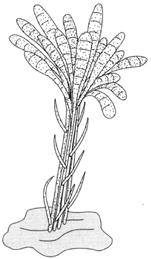Moniliales
 |
| Figure 21-1 A synnema: tightly compacted hyphae bearing conidiospores |
Fungi Imperfecti is also called Deuteromycetes. The largest group within Deuteromycetes is Moniliales, which includes more than 10,000 species. Many of these cause serious diseases. One example is Cercospora. It causes several plant diseases including leaf spot of beets and tobacco, early blight of celery, and infections of several other crops. Approximately 3,800 species of Cercospora have been described.
Injury to the mycelia of moniliales can result in the formation of pycnidia in the region of injury. In a laboratory culture of fungus growing on agar, a cut made across the surface of the growth will often stimulate the production of reproductive bodies along the line of the cut. This again illustrates an observation made earlier: unfavorable living conditions appear to encourage reproduction. This particular event may be related to the production of a hormone.
Conidiophores in Moniliales sometimes unite at the base and part way up toward the tip to form a structure called a synnema. A synnema can become much branched where conidia arise at the tips. This type of fruiting body is said to resemble a long-handled feather duster (see figure 21-1).




